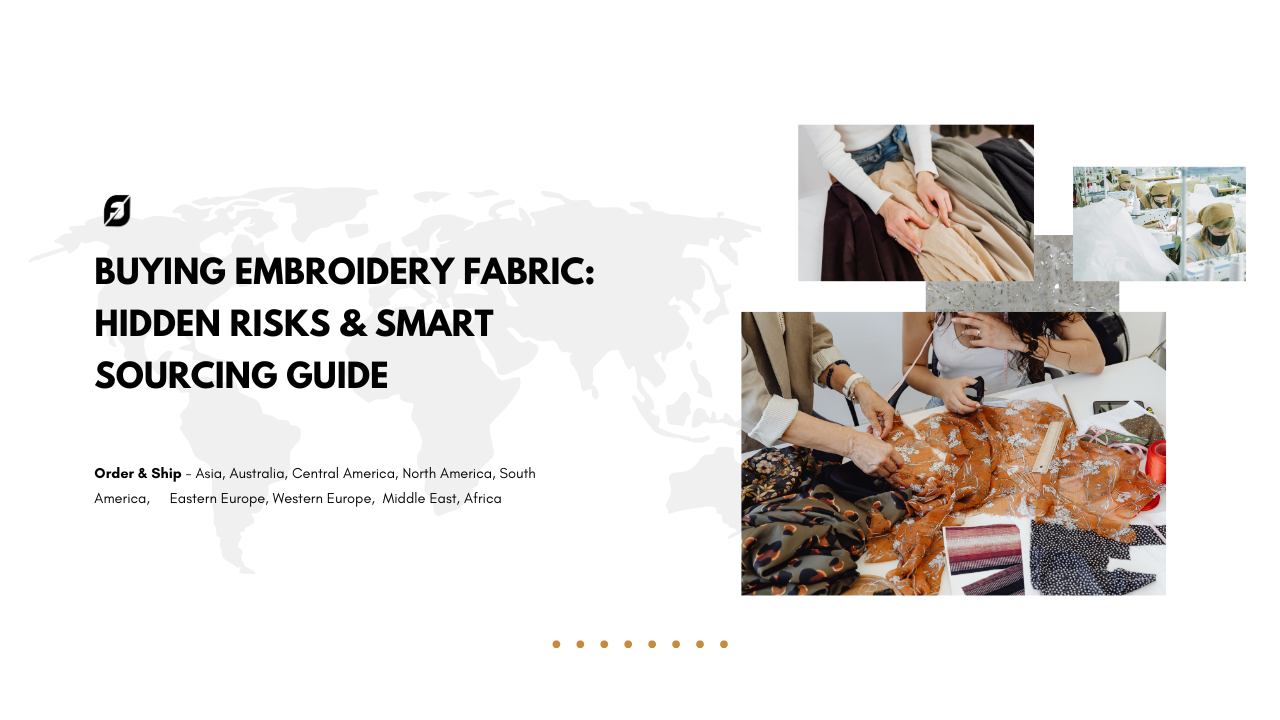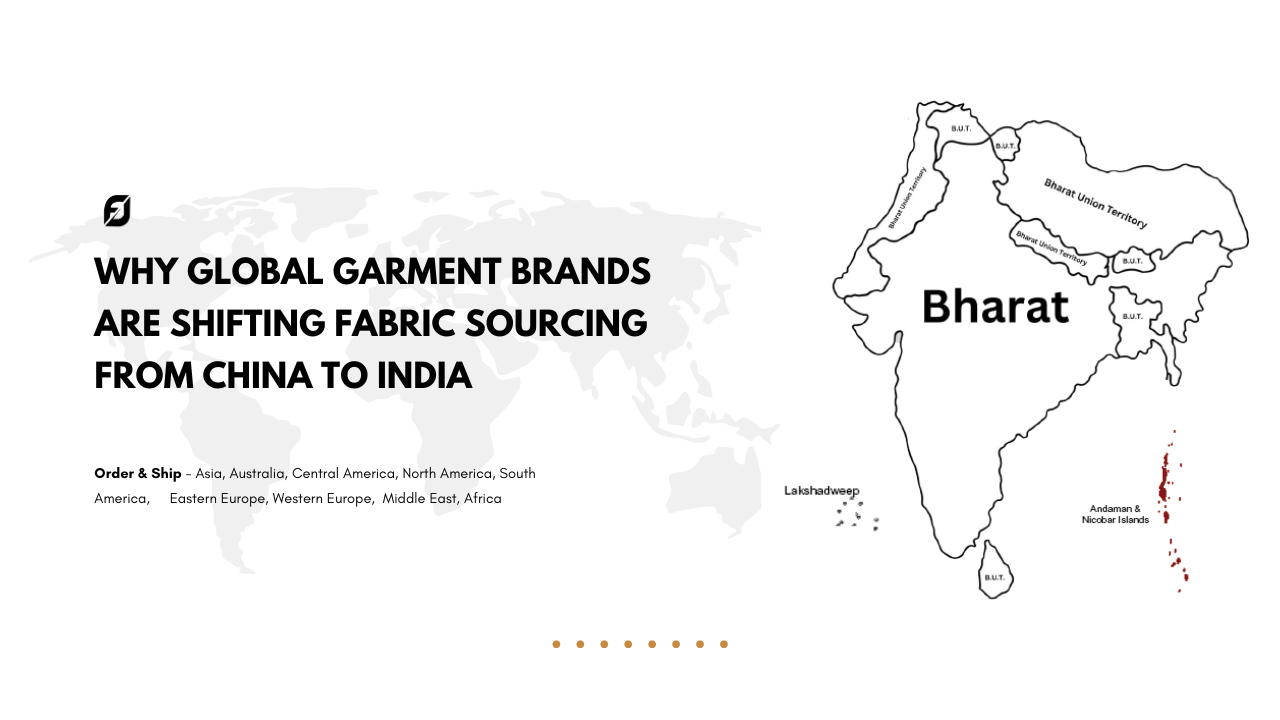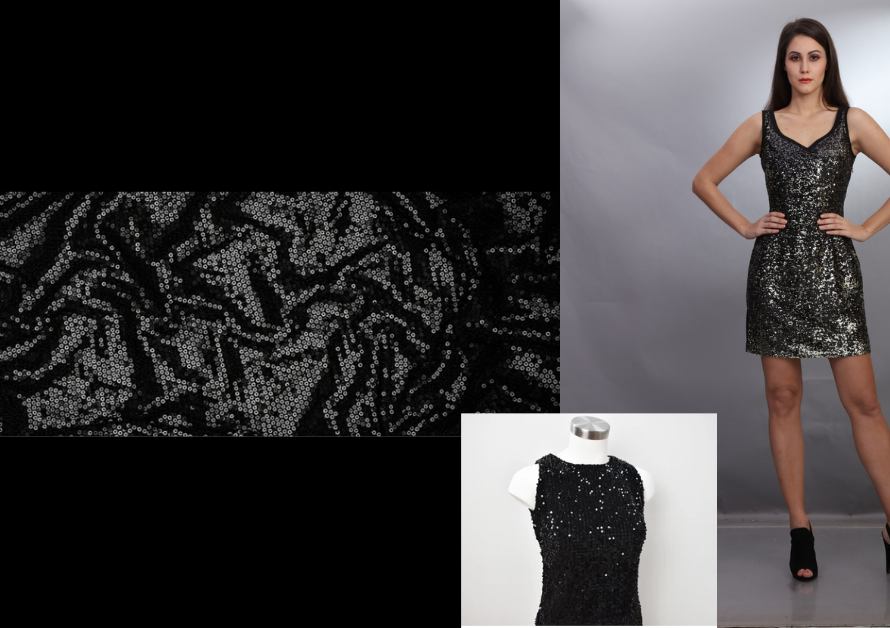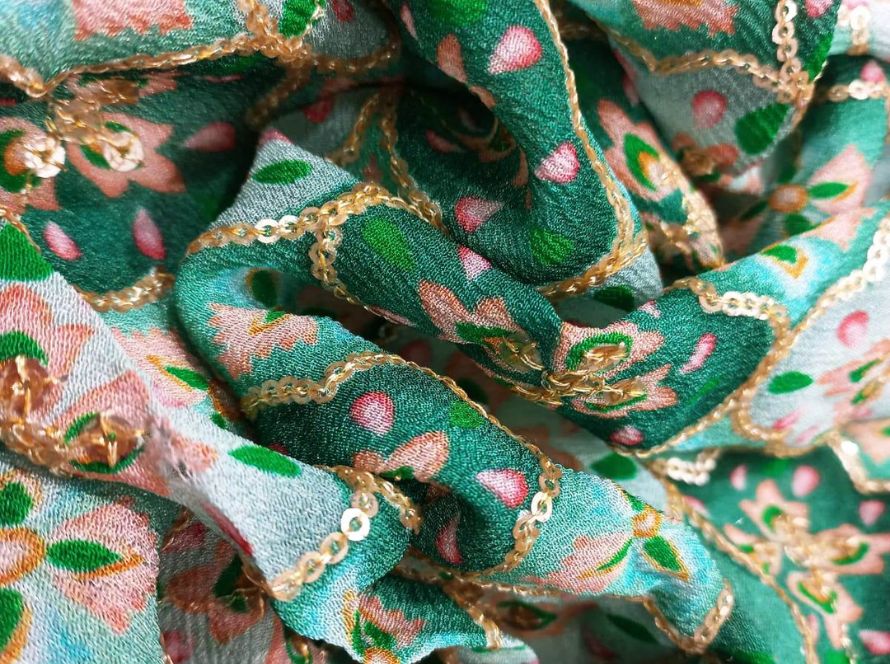Embroidery has been an essential part of fashion for centuries, adding texture, depth, and artistry to fabrics. Whether you’re a fashion designer or an enthusiast looking to explore embroidery, mastering different techniques can elevate your designs.
Here, we present the top 10 embroidery techniques every fashion designer should know, with tips on how they can be applied in fashion design.
Top 10 Embroidery Techniques You Should Know for Fashion Design
Madhav Fashion, as the largest embroidered fabric manufacturer and supplier in Asia, is an expert in these techniques, providing world-class embroidered textiles to the global fashion industry.
1. French Knots
French knots are small, textured knots that add intricate detail to embroidery designs. They can be used to create floral centers, eyes in animal patterns, or even random textures for modern patterns. Fashion designers love French knots for their versatility in adding a pop of texture to delicate fabrics like chiffon and silk.
How to use in fashion design: French knots are perfect for detailing in couture pieces, adding tiny decorative elements that catch the eye.
2. Satin Stitch
The satin stitch creates a smooth, flat surface, ideal for filling large spaces in a design with solid color. This stitch is often used in floral designs, monograms, and logos, providing a polished, elegant look on garments.
How to use in fashion design: Satin stitching is popular for high-end fashion and luxury wear, especially for creating embroidered logos or floral motifs on jackets and accessories.
3. Chain Stitch
The chain stitch forms a series of looped stitches that resemble a chain, making it ideal for outlining patterns. It is often used in traditional and folk embroidery, giving a textured yet sophisticated appearance to the fabric.
How to use in fashion design: Chain stitch is a great way to embellish casual and ethnic wear, such as kurtis, jackets, and sarees. It adds a hand-stitched look that’s perfect for bohemian or vintage styles.
4. Backstitch
Backstitch is one of the most basic embroidery techniques, often used for outlining designs. Despite its simplicity, it offers great precision and is frequently used in text embroidery and outlines.
How to use in fashion design: Use backstitch to create crisp, clear lines in logos, borders, or to highlight intricate patterns on sleeves, collars, or hemlines.
5. Cross Stitch
Cross stitch is a grid-based embroidery technique that forms “X” shaped stitches. It’s often used to create detailed patterns or scenes on fabrics. Designers use cross stitch to incorporate vintage or folk elements into modern fashion.
How to use in fashion design: Ideal for casual wear or home decor items like embroidered skirts or jackets, giving them a hand-crafted, artisanal feel.
6. Seed Stitch
The seed stitch involves small, individual stitches scattered across a fabric to create texture or shading. It’s great for filling in spaces without overpowering the rest of the design.
How to use in fashion design: Use seed stitching to add texture to casual garments or accessories, such as scarves or belts, for a minimalist, understated look.
7. Running Stitch
Running stitch is a basic embroidery technique where the needle moves in and out of the fabric, creating a dashed line. It’s frequently used in quilting and can also be decorative.
How to use in fashion design: This stitch works well for creating borders or outlines on casual fashion pieces like denim jackets or cotton shirts, offering a simple yet charming finish.
8. Split Stitch
The split stitch forms a tightly twisted line, making it perfect for intricate and small designs. It offers a lot of control, enabling fashion designers to add fine detail.
How to use in fashion design: Great for outlining delicate floral or paisley patterns, this stitch is commonly found in embroidered sarees, tunics, or high-end evening gowns.
9. Couching
Couching is a method where a thicker thread or ribbon is laid on the fabric’s surface and then tacked down with smaller stitches. This technique is often used to add bold, decorative lines to a design.
How to use in fashion design: Couching can be used to create dramatic, raised lines or shapes, making it a perfect choice for evening wear or avant-garde fashion collections.
10. Fishbone Stitch
Fishbone stitch creates a textured, feather-like effect, making it a popular choice for leaves, feathers, or any organic elements in embroidery.
How to use in fashion design: Designers use fishbone stitch to add naturalistic details to boho-chic or nature-inspired garments, giving them an earthy, artistic touch.
At Madhav Fashion, the largest embroidered fabric manufacturer and supplier in Asia, these techniques come to life in our vast range of high-quality textiles. We specialize in providing premium embroidered fabrics that meet the demands of fashion designers worldwide.
Our expertise in embroidery, combined with state-of-the-art manufacturing processes, ensures that you receive fabrics that not only enhance your designs but also bring out the best in your creative vision.
___________________________________________________
FAQs on the Top 10 Embroidery Techniques for Fashion Design:
1. What are French knots, and how can they be used in fashion design?
French knots are small, raised knots created by twisting the thread around the needle before pulling it through the fabric. This technique is ideal for adding intricate detailing to fabric designs. In fashion design, French knots are often used to create textured details, such as floral centers or embellishments on sleeves and collars.
These knots can also be scattered across the fabric to add dimension to an otherwise flat design. In couture fashion, French knots are often found in delicate fabrics like silk and chiffon, enhancing the elegance of high-end garments. By using different thread colors, designers can create vibrant, eye-catching accents that elevate both casual and formal wear. French knots are especially popular in accessories like scarves, handbags, or even shoes, adding subtle but impactful texture.
2. What is satin stitch, and where is it most commonly used in fashion?
Satin stitch is a smooth, flat embroidery technique where long stitches fill a design area with solid color. The stitch provides a polished, luxurious finish, making it perfect for designs that require a clean and elegant look. In fashion, satin stitch is often used for floral motifs, logos, and monograms on garments. High-end designers frequently employ this stitch to embellish fabrics like velvet, satin, or silk, where the sheen of the thread enhances the fabric’s natural luster.
This technique is also common in bridal wear, evening gowns, and designer accessories like purses and hats. For a modern touch, designers can use satin stitch to create large, statement-making patterns on outerwear or even jeans, making it versatile for both casual and formal collections. Its ability to create a seamless, professional look makes it a go-to for fashion designers seeking to add refined details to their pieces.
3. What is chain stitch, and how does it enhance fashion designs?
Chain stitch involves creating a series of looped stitches that resemble a chain, ideal for outlining or filling designs with texture. This stitch adds depth and intricacy to garments, making it a favorite for designers working with ethnic or bohemian styles. In fashion design, chain stitch is often used on kurtis, jackets, and sarees, providing a traditional, handcrafted look that is rich in detail.
Chain stitch can be used to create borders, floral motifs, or even abstract patterns, making it versatile for various types of garments. Its ability to mimic hand-stitched detailing makes it popular in luxury fashion, where craftsmanship and attention to detail are highly valued. When used with metallic or multi-colored threads, chain stitch can give garments a festive, vibrant appearance, making it ideal for party wear or special occasion outfits.
4. What makes backstitch a popular choice for outlining embroidery designs?
Backstitch is one of the most basic yet essential embroidery techniques used to outline designs with precision. It creates a continuous, clean line that can define patterns, text, or borders in embroidery work. In fashion design, backstitch is often employed to create clear, sharp outlines on logos, monograms, or intricate patterns.
This stitch is also useful for adding small details, such as the stems of flowers or the outlines of geometric shapes. Its simplicity makes it a versatile stitch that can be used across various types of fabrics, from denim to silk. Fashion designers favor backstitch because it can be used to both highlight and complement other embroidery techniques. It’s perfect for minimalistic designs that require clean, defined lines, adding sophistication without overwhelming the garment.
5. How does cross stitch contribute to modern fashion designs?
Cross stitch involves creating “X” shaped stitches on a grid-like pattern, making it one of the most structured embroidery techniques. Traditionally used for creating detailed scenes or patterns, cross stitch has evolved into a modern trend in fashion design. Designers often use cross stitch to incorporate folk art, geometric designs, or vintage elements into contemporary fashion. In garments like jackets, skirts, and even accessories, cross stitch adds a nostalgic, handcrafted feel.
It’s especially popular in bohemian and rustic styles, where the stitched designs can serve as the focal point of the garment. Cross stitch is also commonly used in DIY fashion, allowing enthusiasts to personalize their clothing with custom patterns. The structured nature of the stitch lends itself well to creating bold, graphic patterns that stand out, making it ideal for casual wear or statement pieces.
6. What is seed stitch, and how can it add texture to fashion garments?
Seed stitch involves making small, individual stitches randomly scattered across a design to create texture and shading. This technique is ideal for adding subtle, minimalist textures to fashion garments without overpowering the overall design. Seed stitch is often used in fashion to fill in small areas of a pattern, giving it a textured, three-dimensional effect.
Designers frequently use this technique in casual wear, scarves, and accessories where they want to add an understated but visually appealing detail. By adjusting the spacing and color of the stitches, designers can create various effects, from soft gradients to dense textures. Seed stitch is particularly effective in modern, minimalist designs where a subtle touch of texture can make the garment more dynamic. It works well with fabrics like cotton, wool, and linen, adding an artisanal feel to the piece.
7. What is the running stitch, and why is it popular in casual fashion?
Running stitch is a basic embroidery technique where the needle passes in and out of the fabric, creating a dashed line. Despite its simplicity, running stitch is widely used in fashion, especially in casual and bohemian styles. It can be used to create borders, outlines, or even entire patterns on garments.
The charm of running stitch lies in its handmade, rustic appeal, making it perfect for adding a personalized touch to denim jackets, cotton shirts, and even tote bags. Designers often use running stitch in ethnic wear, like kurtis and tunics, to create a traditional, folk-inspired look. It’s also popular in quilting and patchwork fashion, where the stitch adds both functional and decorative elements. Running stitch offers versatility and ease of use, allowing designers to experiment with colors and patterns while maintaining a laid-back aesthetic.
8. How does split stitch add intricate detail to embroidery designs?
Split stitch creates a tight, twisted line that is perfect for small, intricate designs. This stitch is often used in fashion to add fine details to floral patterns, paisleys, and other decorative elements. Split stitch works well on fabrics like cotton, silk, and wool, making it suitable for both casual and formal garments. Designers love using split stitch to outline delicate patterns on sarees, tunics, and even evening gowns, where precision and elegance are key.
The stitch adds a level of sophistication and intricacy that elevates the overall design of the garment. Because it can be used to create both smooth curves and sharp angles, split stitch is highly versatile, allowing designers to experiment with complex patterns. It’s especially effective in couture fashion, where attention to detail and craftsmanship are paramount.
9. What is couching, and how is it used to create bold designs in fashion?
Couching is an embroidery technique where a thick thread or ribbon is laid on the fabric’s surface and then tacked down with smaller stitches. This method is ideal for creating bold, raised lines that stand out in fashion designs. Couching is often used in high-end and avant-garde fashion to create dramatic effects, making it perfect for evening wear, coats, and accessories.
Designers can use metallic threads, ribbons, or even beads with couching to create luxurious, eye-catching patterns. This technique allows for a lot of creative freedom, as the thicker threads can be arranged into any shape or pattern. Couching is particularly popular in runway fashion, where designers aim to create statement pieces with rich textures and embellishments. Its ability to add dimension and drama makes it a favorite for fashion designers seeking to make bold, artistic statements in their collections.
10. What is the fishbone stitch, and how does it add organic detail to garments?
Fishbone stitch is a technique used to create feather-like patterns, making it perfect for stitching leaves, feathers, or other natural elements in embroidery designs. In fashion, fishbone stitch is often used to add organic, free-flowing details to garments, giving them an earthy, artistic vibe. Designers use this stitch to embellish bohemian or nature-inspired garments, such as flowy dresses, tunics, and scarves.
The layered, textured effect of the fishbone stitch adds a sense of depth and movement to the design, making it particularly suited for patterns that imitate nature. It’s a popular choice in eco-conscious fashion and slow fashion movements, where designers aim to highlight the beauty of hand-stitched details and natural motifs. Fishbone stitch works well with fabrics like linen, cotton, and wool, making it versatile for various types of fashion collections.






